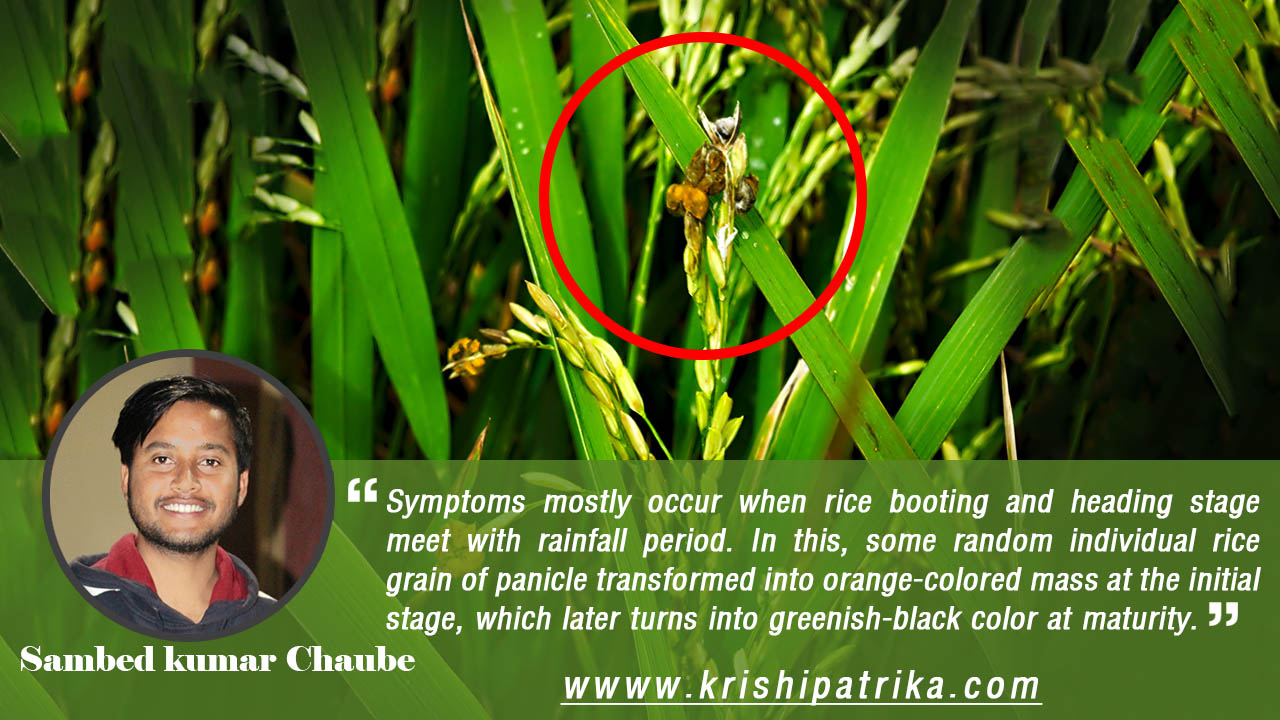
Rice is the major source that provides food security to the global population. Every Crop has a particular disease among which the most occurring disease in Rice crop is False Smut of Rice. It is the most important rice grain disease which results in the considerable loss in grain yield, grain quality, and seed germination as well.
It is a fungal disease of rice which is caused by pathogen named Ustilaginoidea virens. The host of this pathogen is grasses and wild rice. It is more severe in the area of high rainfall.
Symptoms of False Smut of Rice :
Symptoms are seen during the early stage of flowering and maturity of grain. Symptoms mostly occur when rice booting and heading stage meet with rainfall period. In this, some random individual rice grain of panicle transformed into orange-colored mass at the initial stage, which later turns into greenish-black color at maturity. The greenish-black color mass is also called False Smut ball (FSB).
The greenish-black colored mass i.e. FSB of 1cm diameter covers the floral part of the individual grain of panicle. The mass consists of a mixture of fungal tissues and a floral part that is enclosed with a whitish membrane, which later gets burst and dries over the grain giving greenish-black color appearance.
It is not possible that all of the grain in the panicle can get transformed, but a little of all grain can have unfilled grain due to neighbor affected grain.
Pathogenesis :
At the panicle developing stage in some of the random rice grain (Spikelet) Ustilaginoidea virens comes in contact with developing spikelets and germinates over the surface of it. The hyphae of pathogen get extended into the inner space of spikelet through the gap between lemma and palea. This primarily infects the stamen filament intercellularly, lodicules, and stigma is also attacked but to a little extent. After some time, mycelia grow and encloses the floral organ and protrude out of spikelet and ultimately form a ball-shaped colony covered with chlamydospores.
Reason for the occurrence of False Smut
- Weather with more than 90% relative humidity, frequent rain, and temperature ranging from 25⁰-30⁰c are favorable for fungus attack and their growth.
- Overuse of nitrogenous fertilizer than the recommended doses.
- Late planting of rice has more chances of fungus attack.
- High-speed wind carry out spores from the infected area to a non-attacked field.
Health hazard resulted due to False Smut of Rice
The false smut ball (FSB) produces two types of mycotoxins i.e. Ustiloxin & Ustilaginoidin which are poisonous to both animal and human. These mycotoxins may cause kidney and liver damage and significantly other health hazards by contaminating rice grain and straw.
Best management practices to control the incidence of False Smut of rice:-
- Seed treatment with carbendazim @2.0gm/kg
- Seed treatment at 52⁰C for 10minute is significantly working to reduce the incidence of this disease.
- Chemical control i.e. fungicide application can be effective but is often not economical and environment-friendly.
- Early planting of the rice reduces the incidence of false smut
- Use of disease resistance variety
- Sensible uses of nitrogenous fertilizer in split doses enhance the stress tolerance of rice plants and ultimately reduce the incidence.
- Deep plowing and soil solarization of field after crop harvest.
- Follow 2-3 year crop rotation
- Remove infected panicles so that further spreading can be prevented.
- Field ridge and irrigation channel should be kept clean to prevent the alternative hosts.
Writer : Sambed Kumar Chaube









